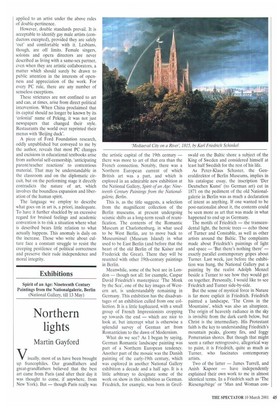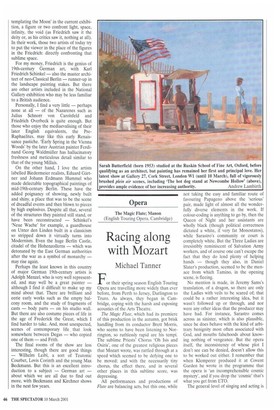Exhibitions
Spirit of an Age: Nineteenth Century Paintings from the Nationalgalerie, Berlin (National Gallery, till 13 May)
Northern lights
Martin Gayford
Visually, most of us have been brought up francophiles. Our grandfathers and great-grandfathers believed that the best art came from Paris (and after their day it was thought to come, if anywhere. from New York). But — though Paris really was
the artistic capital of the 19th century — there was more to art of that era than the French connection. Notably, there was a Northern European current of which British art was a part, and which is explored in an admirable new exhibition at the National Gallery, Spirit of an Age: Nineteenth Century Paintings from the Nationalgalerie. Berlin.
This is, as the title suggests, a selection from the magnificent collection of the Berlin museums, at present undergoing seismic shifts as a long-term result of reunification. The contents of the Romantic Museum at Charlottenburg, in what used to be West Berlin, are to move back to Museuminsel (Museum Island) in what used to be East Berlin (and before that the heart of the old Berlin of the Kaiser and Frederick the Great). There they will be reunited with other 19th-century paintings in Berlin.
Meanwhile, some of the best are in London — though not all; for example, Caspar David Friedrich's masterpiece 'The Monk by the Sea', one of the key images of Western art, is understandably remaining in Germany. This exhibition has the disadvantages of an exhibition culled from one collection. It is a little haphazard, with a small group of French Impressionists cropping up towards the end — which are nice to look at, but interrupt what is otherwise a splendid survey of German art from Romanticism to the dawn of Modernism.
What do we see? As I began by saying, German Romantic landscape painting was part of a Northern European tendency. Another part of the mosaic was the Danish painting of the early-19th century, which was explored in another National Gallery exhibition a decade and a half ago. It is a little arbitrary to designate some of the work on show in this exhibition as German. Friedrich, for example, was born in Greif
swald on the Baltic shore a subject of the King of Sweden and considered himself at least half Swedish for the rest of his life.
As Peter-Klaus Schuster. the Generaldirektor of Berlin Museums, implies in his catalogue essay, the inscription 'Der Deutschen Kunst' (to German art) cut in 1871 on the pediment of the old Nationalgalerie in Berlin was as much a declaration of intent as anything. If one wanted to be post-nationalist about it, the contents could be seen more as art that was made in what happened to end up as Germany.
The motifs of Friedrich — the transcendental light, the heroic trees — echo those of Turner and Constable, as well as other artists around the Baltic. The complaints made about Friedrich's paintings of light and space — 'But there's nothing there' — exactly parallel contemporary gripes about Turner. Last week, just before the exhibition was hung, the National Gallery put a painting by the realist Adolph Menzel beside a Turner to see how they would get on together. Personally, I would like to see Friedrich and Turner side-by-side.
But the sense of mystical force in Nature is far more explicit in Friedrich. Friedrich painted a landscape, 'The Cross in the Mountains', which was also an altarpiece. The origin of heavenly radiance in the sky is invisible from the dark earth below, but Christ is the intermediary. His Protestant faith is the key to understanding Friedrich's mountain peaks, gloomy firs, and foggy Pomeranian shores. But though that might seem a rather retrogressive, allegorical way to paint, it is Friedrich, quite as much as Turner, who fascinates contemporary artists.
Two of the latter — James Turrell, and Anish Kapoor — have independently explained their own work to me in almost identical terms. In a Friedrich such as 'The Riesengebirge or 'Man and Woman con templating the Moon' in the current exhibition, a figure or two confront light, space, infinity, the void (as Friedrich saw it the deity or, as his critics saw it, nothing at all). In their work, those two artists of today try to put the viewer in the place of the figures in the Friedrich: directly confronting that sublime space.
For my money, Friedrich is the genius of 19th-century German art, with Karl Friedrich Schinkel — also the master architect of neo-Classical Berlin — runner-up in the landscape painting stakes. But there are other artists included in the National Gallery exhibition who may be less familiar to a British audience.
Personally, I find a very little — perhaps none at all — of the Nazarenes such as Julius Schnorr von Carolsfeld and Friedrich Overbeck is quite enough. But those who enjoy the mediaevalising of their later English equivalents, the PreRaphaelites, may like this early Renaissance pastiche. 'Early Spring in the Vienna Woods' by the later Austrian painter Ferdinand Georg Waldmiiller has hallucinatory freshness and meticulous detail similar to that of the young Millais.
On the other hand, I love the artists labelled Biedermeier realists, Eduard Gartner and Johann Erdmann Hummel who made delectable topographical paintings of mid-19th-century Berlin. These have the added poignancy of showing, newly built and shiny, a place that was to be the scene of dreadful events and then blown to pieces by high explosives. Despite all that, several of the structures they painted still stand, or have been reconstructed — Schinkel's `Neue Wache' for example, a guardhouse on Unter den Linden built in a classicism so stripped down it virtually turns into Modernism, Even the huge Berlin Castle, citadel of the Hohenzollerns — which was detonated by the East German authorities after the war as a symbol of monarchy — may rise again.
Perhaps the least known in this country of major German 19th-century artists is Adolph Menzel, who is very well represented, and may well be a great painter — although I find it difficult to make up my mind about that. There are brilliant and eerie early works such as the empty balcony room, and the study of fragments of casts — body parts — on his studio wall. But there are also costume pieces of life in the age of Frederick the Great, which I find harder to take. And, most unexpected, scenes of contemporary life, that look somewhere between Degas — who copied one of them — and Frith.
The final rooms of the show are less interesting, though there are good things — Wilhelm Leibl, a sort of Teutonic Courbet, Levis Corinth and the young Max Beckmann. But this is an excellent introduction to a subject — German art — about which we are all due to find out more, with Beckmann and Kirchner shows in the next few years.



































































 Previous page
Previous page